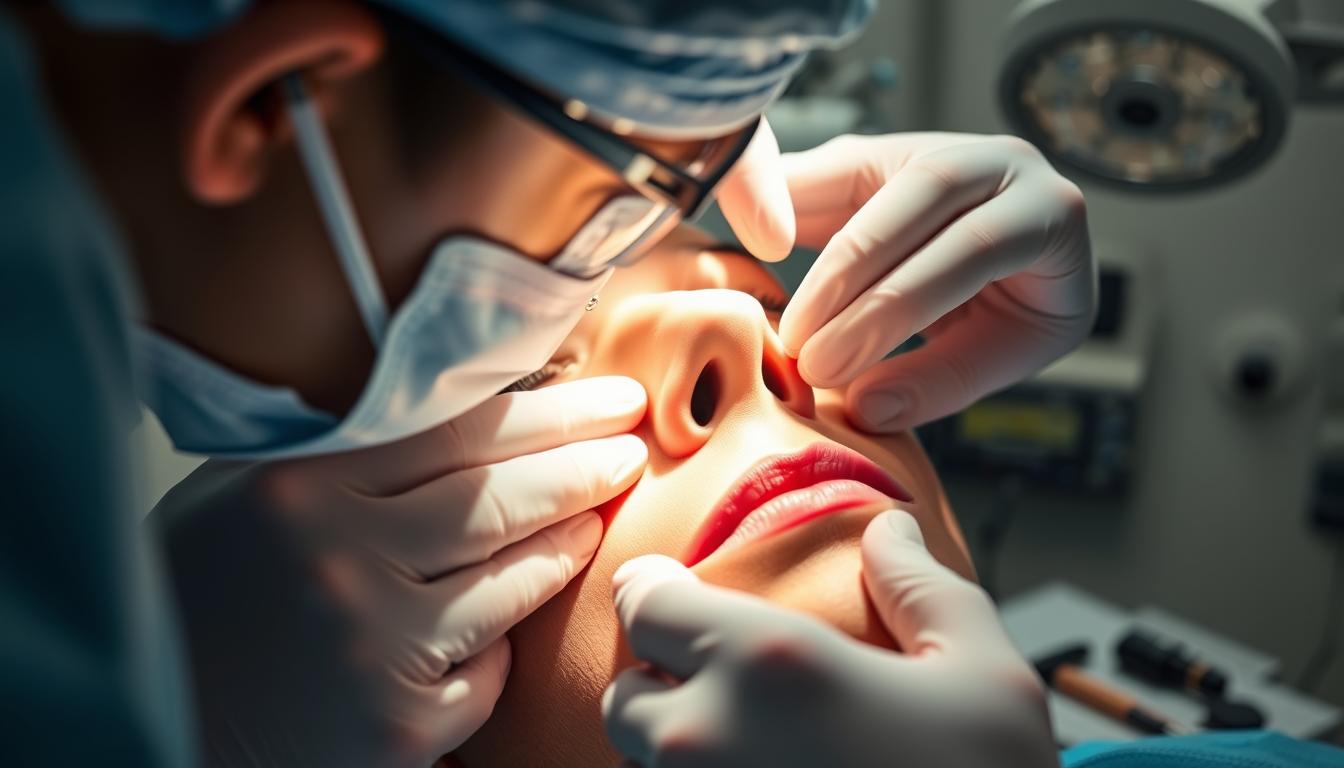The pursuit of a perfectly shaped nose has led to the rise of innovative cosmetic procedures. One such technique is the Korean Nose Lift, a non-surgical method that has garnered international attention for its effectiveness.
This procedure, also known as the “lunchtime nose job,” utilizes polydioxanone (PDO) threads to enhance the contours and height of the nose without invasive plastic surgery.
The Korean approach to nasal reshaping emphasizes natural-looking results that complement an individual’s facial features. As a result, this technique has become a popular choice among those seeking subtle yet effective enhancements.
Key Takeaways
- Understanding the different types of rhinoplasty procedures available.
- Learning how to select a qualified surgeon for your nose reshaping needs.
- Gaining insight into the decision-making process for procedure selection.
- Discovering the benefits of non-surgical nose lifts.
- Setting realistic expectations for your results.
Understanding Korean Nose Lift Procedures
Understanding the nuances of Korean nose lift procedures is essential for those considering this cosmetic surgery. The Korean nose lift is a sophisticated procedure that aims to enhance the nose’s shape and structure while maintaining a natural appearance.
What Is a Korean Nose Lift?
A Korean nose lift encompasses a range of surgical and non-surgical procedures designed to enhance the nose’s height and overall structure. Unlike traditional rhinoplasty, Korean nose lift techniques focus on creating a more defined tip and a higher bridge that complements Asian facial features.
How Korean Techniques Differ from Western Approaches
Korean methods typically emphasize augmentation to create a more balanced facial profile. Korean surgeons analyze the entire facial structure to ensure that the nose enhancement is in harmony with other facial features, considering the ideal ratio between the forehead, eyebrows, nose, and chin.
- The philosophy behind Korean nose lift techniques prioritizes subtle enhancements that preserve ethnic identity.
- Advanced technology allows Korean surgeons to achieve precise results with minimally invasive techniques, reducing recovery time.
- Korean nose lift procedures often incorporate cartilage grafting to provide structural support and natural-looking contours.
The comprehensive approach to Korean nose lift includes detailed pre-operative analysis, customized surgical planning, and extensive post-operative care to ensure optimal healing and patient satisfaction.
Types of Korean Nose Lift Procedures
In the realm of cosmetic surgery, Korean nose lift procedures stand out for their advanced techniques and minimal invasiveness. These procedures cater to a variety of needs, offering solutions that range from non-surgical adjustments to more permanent surgical alterations.
Nose Thread Lift
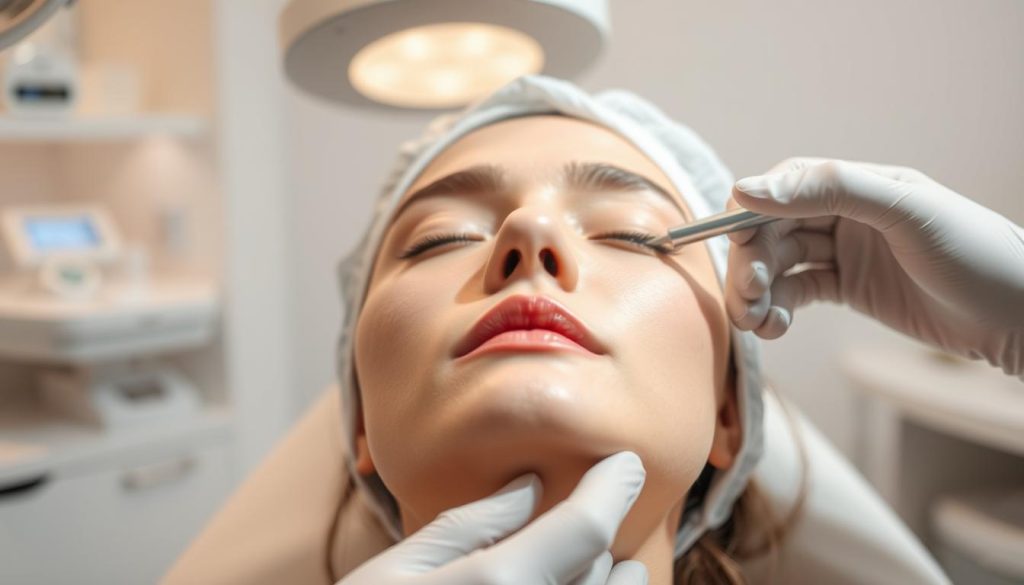
Nose Thread Lift is a minimally invasive procedure that utilizes dissolvable PDO threads to lift and reshape the nose, providing immediate results with minimal downtime. This technique is popularly known as a “lunchtime nose job” due to its quick nature.
The threads not only offer immediate structural support but also stimulate collagen production over time, creating a natural-looking enhancement that can last 6-12 months. This method is ideal for those seeking a temporary solution with minimal recovery time.
Nose Sculpting Injection
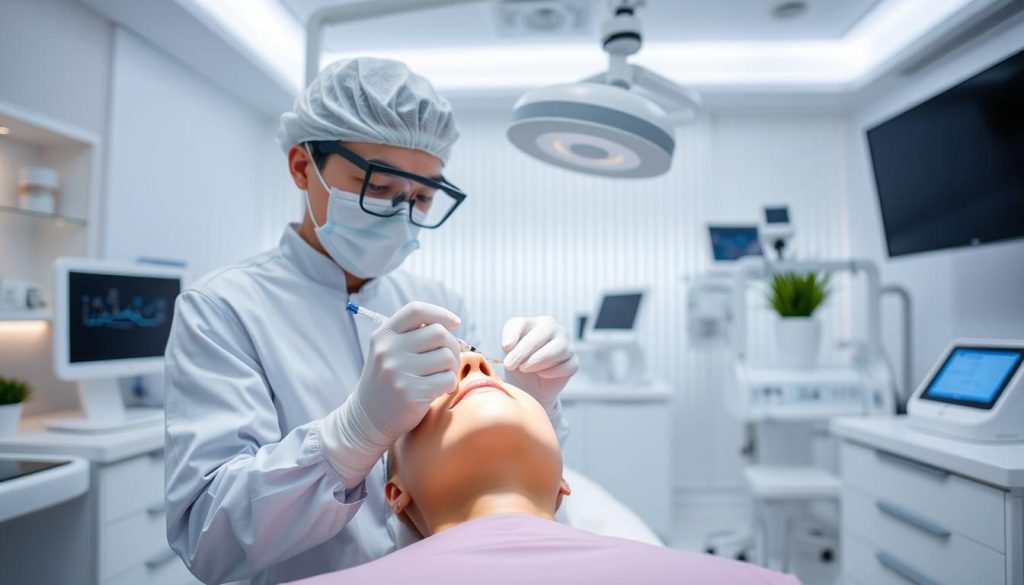
Nose Sculpting Injection, often referred to as non-surgical rhinoplasty or liquid rhinoplasty, uses injectable fillers to alter the nose’s structure and appearance. This technique is particularly useful for smoothing bumps, refining the tip, or creating a more defined bridge.
The injectable approach offers immediate results with minimal recovery, though the results are temporary, lasting 6-18 months. It is best suited for minor to moderate adjustments rather than significant structural changes.
Traditional Rhinoplasty
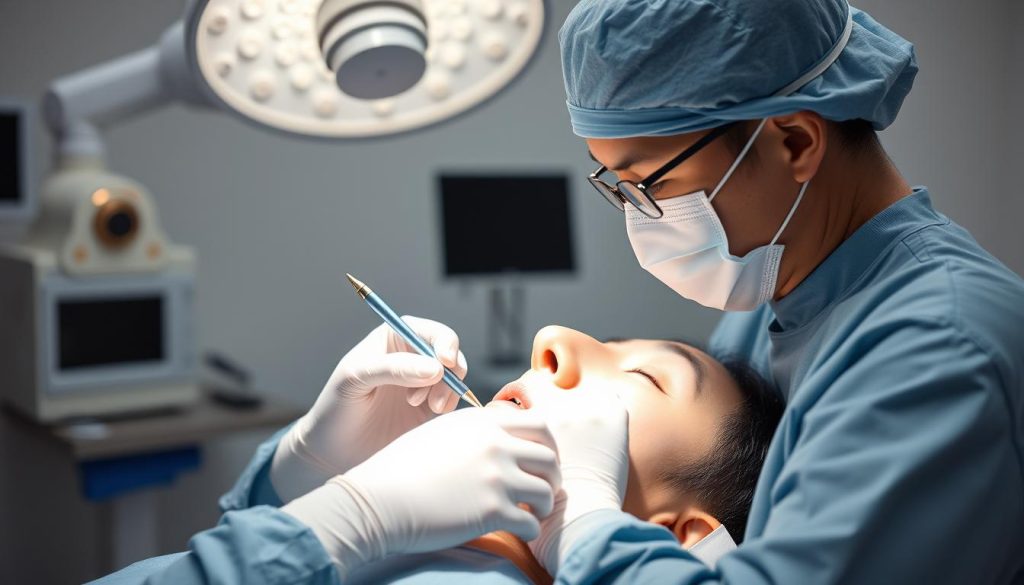
Traditional Rhinoplasty remains the most comprehensive option, involving surgical modification of the bone and cartilage structure to permanently alter the nose’s shape, size, and function. Korean rhinoplasty techniques often incorporate autologous materials (patient’s own cartilage from septum, ear, or rib) to create natural-looking results that harmonize with Asian facial features.
Each procedure type offers different benefits in terms of invasiveness, recovery time, longevity of results, and degree of possible change, allowing patients to choose based on their specific needs and preferences.
Ideal Candidates for a Korean Nose Lift
To be considered an ideal candidate for a Korean nose lift, one must have realistic expectations and meet specific physical criteria. The Korean nose lift has emerged as a popular cosmetic procedure, attracting a diverse range of individuals seeking to enhance their nasal appearance and structure.
Physical Considerations
Ideal candidates for Korean nose lift procedures are generally healthy individuals who have fully developed facial structures, typically those over 18 years of age. Physical considerations include having adequate cartilage for grafting if autologous materials are needed, good skin elasticity, and no significant medical conditions that could impair healing.
- Candidates with specific nasal concerns such as a low bridge, bulbous tip, short nose, or minor asymmetry often achieve the most satisfying results from Korean nose lift techniques.
- Having a clear understanding of one’s nasal shape and the desired changes is crucial for a successful outcome.
Realistic Expectations
Psychological readiness is crucial—patients should be pursuing the procedure for personal satisfaction rather than to fulfill someone else’s expectations or to solve non-physical problems. Realistic goals are essential; candidates should understand that while Korean nose lift procedures can significantly improve appearance, the goal is enhancement rather than perfection.
- People seeking subtle enhancements, such as a slightly higher bridge or a more defined tip, are often ideal candidates.
- Non-smokers or those willing to quit smoking before and after the procedure make better candidates due to improved healing capabilities and reduced risk of complications.
- Patients should be prepared for the recovery process, which varies depending on the procedure type, and be willing to follow all pre and post-operative instructions.
By understanding these factors, individuals can make informed decisions about whether a Korean nose lift is right for them, ultimately achieving their desired nasal shape and enhancing their overall facial harmony.
Benefits of Korean Nose Lift Procedures
The benefits of undergoing a Korean nose lift are numerous, ranging from aesthetic improvements to reduced recovery time. These procedures have become increasingly popular due to their ability to enhance the nasal aesthetics while minimizing downtime.
Aesthetic Improvements
Korean nose lift procedures offer significant aesthetic improvements by creating a more defined bridge, refined tip, and improved overall nasal contour that enhances facial harmony. These techniques can correct various nasal concerns, including low bridges, bulbous tips, asymmetry, and minor functional issues, resulting in a more balanced facial appearance.
The use of non-surgical options like thread lifts and injectable fillers provides immediate results with minimal downtime, allowing patients to return to normal activities within 24-48 hours. Even surgical rhinoplasty in Korea emphasizes techniques that minimize trauma and swelling, resulting in faster recovery compared to traditional Western approaches.
Minimal Downtime and Recovery
One of the key benefits of Korean nose lift procedures is the minimal downtime associated with them. Non-surgical procedures, in particular, offer the advantage of quick recovery, with most patients resuming their daily activities almost immediately.
The results of these procedures are not only aesthetically pleasing but also natural-looking, complementing the patient’s facial features rather than producing an obviously “operated” appearance. For patients with breathing difficulties, functional improvements can be achieved alongside aesthetic enhancements, addressing both form and function simultaneously.
The psychological benefits of undergoing a Korean nose lift should not be understated, as improved self-confidence and satisfaction with one’s appearance can positively impact social interactions and quality of life.
Potential Risks and Side Effects
A Korean nose lift, like any cosmetic procedure, comes with its own set of risks and side effects that patients should be aware of. While the procedure is generally considered safe when performed by experienced practitioners, understanding the potential complications is crucial for making an informed decision.
Common Complications
All nose lift procedures, whether surgical or non-surgical, carry potential risks. The severity and likelihood of these risks vary significantly between the different types of procedures. Common side effects include temporary swelling, bruising, and discomfort. For surgical procedures, these effects typically subside within 1-2 weeks, while non-surgical alternatives may see resolution within days.
Surgical Risks: Surgical rhinoplasty carries additional risks, including infection, adverse reaction to anesthesia, breathing difficulties, asymmetry, and unsatisfactory aesthetic results that may require revision surgery.
Non-Surgical Risks: Non-surgical options, such as thread lifts and fillers, have their own specific risks. These include thread migration, asymmetry, vascular complications (though rare), and allergic reactions to the materials used.
| Procedure Type | Common Risks | Typical Recovery Time |
|---|---|---|
| Surgical Rhinoplasty | Infection, asymmetry, breathing difficulties | 1-2 weeks |
| Thread Lift | Thread migration, asymmetry, infection | A few days to 1 week |
| Fillers | Allergic reactions, vascular complications | A few days |
Long-term Considerations
Long-term considerations for nose lift procedures include the potential need for revision procedures, especially with temporary solutions like fillers and threads, which require maintenance treatments to sustain results. Patients with certain skin types may be more prone to scarring or prolonged swelling, factors that should be discussed during consultation to manage expectations.
The psychological impact of complications or unsatisfactory results can be significant. Therefore, choosing experienced practitioners and maintaining realistic expectations are crucial.
By understanding the potential risks and side effects, patients can make informed decisions about undergoing a Korean nose lift procedure. It’s essential to weigh these factors against the potential benefits to determine if the procedure is right for you.
The Korean Nose Lift Experience
Undergoing a Korean nose lift procedure involves several key steps, from initial consultation to post-procedure care. This comprehensive approach ensures that patients receive personalized attention and achieve the desired outcomes.
Consultation Process
The Korean nose lift experience typically begins with a comprehensive consultation where the surgeon analyzes the patient’s facial structure, discusses aesthetic goals, and recommends the most suitable procedure type. Advanced imaging technology is often used during the consultation to simulate potential results, helping patients visualize the expected outcome and make informed decisions.
During this phase, the surgeon will also discuss the anesthesia options and the type of surgery or non-surgical procedure that will be performed. This is a crucial step in setting realistic expectations and ensuring that the patient is comfortable with the planned procedure.
During the Procedure
The procedure itself is minimally invasive and usually takes about 30 to 45 minutes. Local anesthesia is applied to minimize discomfort. The surgeon inserts Polydioxanone (PDO) threads through a cannula into the nasal structure to lift and reshape the nose. The threads provide an immediate lift and stimulate collagen production over the following months, resulting in a natural-looking enhancement.
Korean clinics are known for their attention to detail, with surgeons focusing on precision and artistry to create natural-looking results that complement the patient’s overall facial features.
Post-Procedure Care
Post-procedure care is comprehensive, with detailed instructions for wound care, activity restrictions, and medication management to ensure optimal healing and results. Care instructions are provided to minimize the risk of complications and promote a smooth recovery.
Follow-up appointments are scheduled to monitor healing progress, address any concerns, and ensure patient satisfaction with the outcome. This ongoing care is an essential part of the overall experience, ensuring that the patient achieves the desired results from their nose lift procedure.
By understanding the entire experience, from consultation through post-procedure care, individuals can make informed decisions about undergoing a Korean nose lift procedure.
Recovery Timeline and Aftercare
The recovery timeline and aftercare for a Korean nose lift vary based on the type of procedure performed. Understanding these differences is crucial for patients to manage their expectations and ensure a smooth recovery.
Immediate Recovery (First Week)
During the first week after a Korean nose lift, patients typically experience swelling, bruising, and discomfort. These symptoms are managed with prescribed medications, cold compresses, and keeping the head elevated to reduce swelling. For surgical procedures, nasal packing is usually removed within 1-2 days, and external splints or casts are removed after 5-7 days, marking a significant milestone in the recovery process.
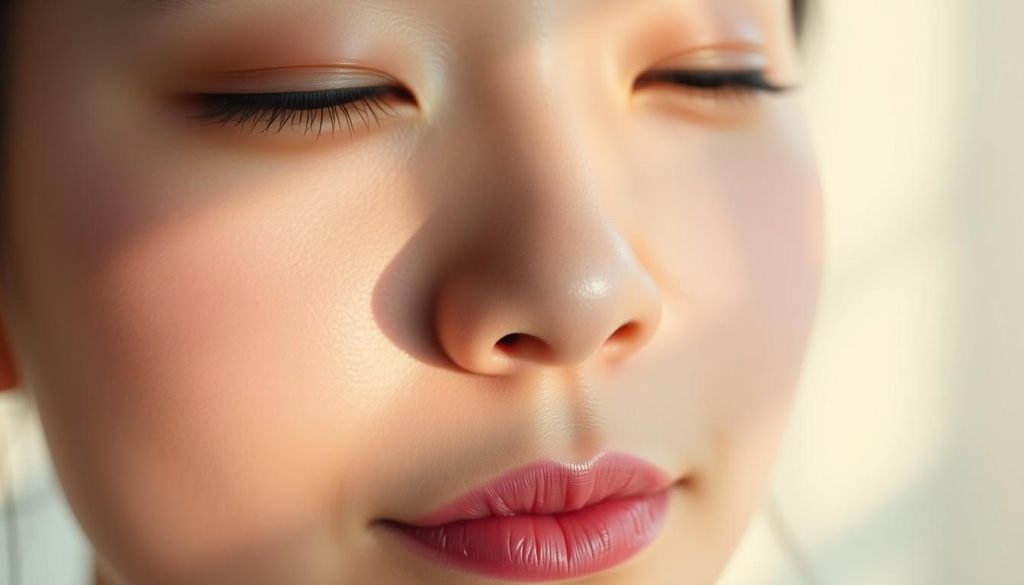
Short-term Recovery (1-4 Weeks)
In the short-term recovery phase, swelling and bruising gradually subside. Most patients can return to work and social activities within 10-14 days, although some residual swelling may persist. It is advised to avoid strenuous activities, excessive sun exposure, and wearing glasses that rest on the nasal bridge for approximately 4-6 weeks to prevent disrupting the healing process.
Long-term Results and Maintenance
Long-term results from a Korean nose lift develop over 6-12 months as all swelling resolves and tissues settle. The final outcome becomes apparent as the nose adapts to its new structure. Maintenance requirements vary by procedure type; surgical results are generally permanent, though aging will naturally affect appearance over time, while thread lifts and fillers require periodic touch-ups to maintain results.
| Procedure Type | Recovery Time | Maintenance Requirements |
|---|---|---|
| Surgical Rhinoplasty | 1-2 weeks | Generally permanent |
| Nose Thread Lift | Few days to 1 week | Periodic touch-ups |
| Nose Sculpting Injection | Minimal downtime | Regular fillers |
Proper care and recovery practices are essential for achieving the desired results from a Korean nose lift. By understanding the recovery timeline and following aftercare instructions, patients can ensure a smooth and successful healing process, ultimately enjoying the full benefits of their procedure.
Top Clinics for Korean Nose Lift in Seoul
The quest for the perfect nose shape leads many to Seoul, where top clinics offer exceptional Korean Nose Lift services. These clinics combine cutting-edge technology with artistic vision, providing patients with personalized treatment plans.
PangPang Clinic
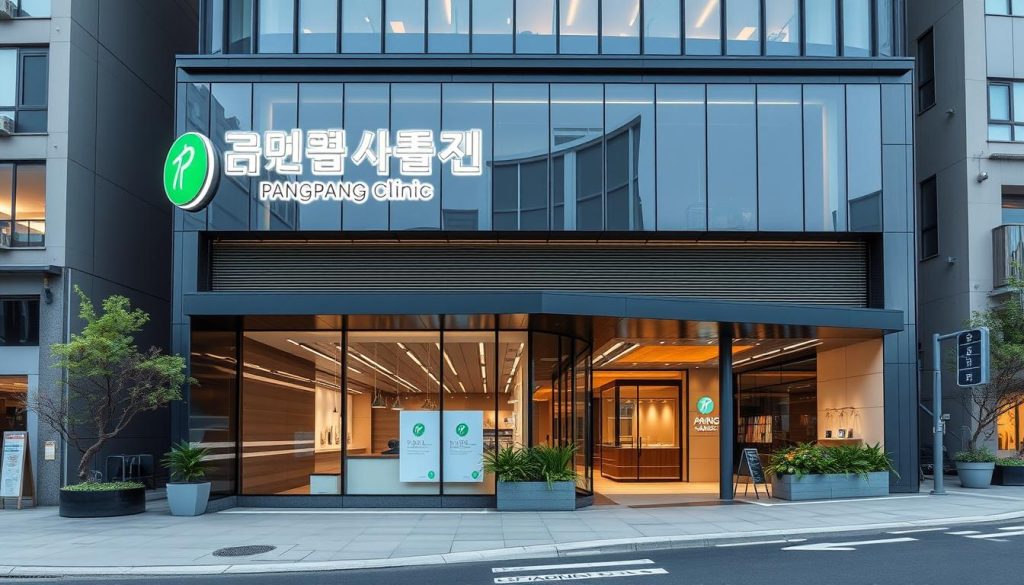
PangPang Clinic, located in the bustling Gangnam district of Seoul, is renowned for its expertise in thread lifting, particularly in nose thread lifts. With over a decade of experience, they have mastered innovative, non-surgical nose lift procedures.
Their comprehensive approach includes various types of threads tailored to specific needs, supported by ultrasonic visual checks and customized treatment plans. This ensures that patients receive the most appropriate care for their individual needs.
Haru Clinic
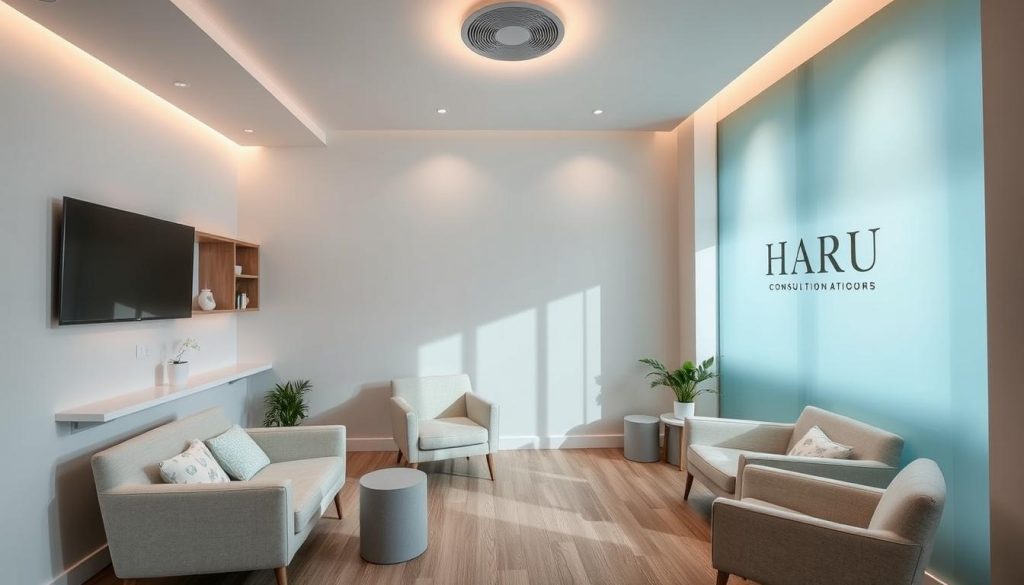
Haru Clinic stands out as a premier destination for nose thread lifts due to its innovative and patient-centered approach. They employ a unique technique that anchors threads behind the ear, ensuring a more stable and long-lasting lift.
Under the guidance of Dr. Jeong, an official research physician at Merz and educator in advanced filler techniques, Haru Clinic offers meticulously tailored procedures that enhance facial harmony while delivering precise, natural-looking results.
B.V Clinic
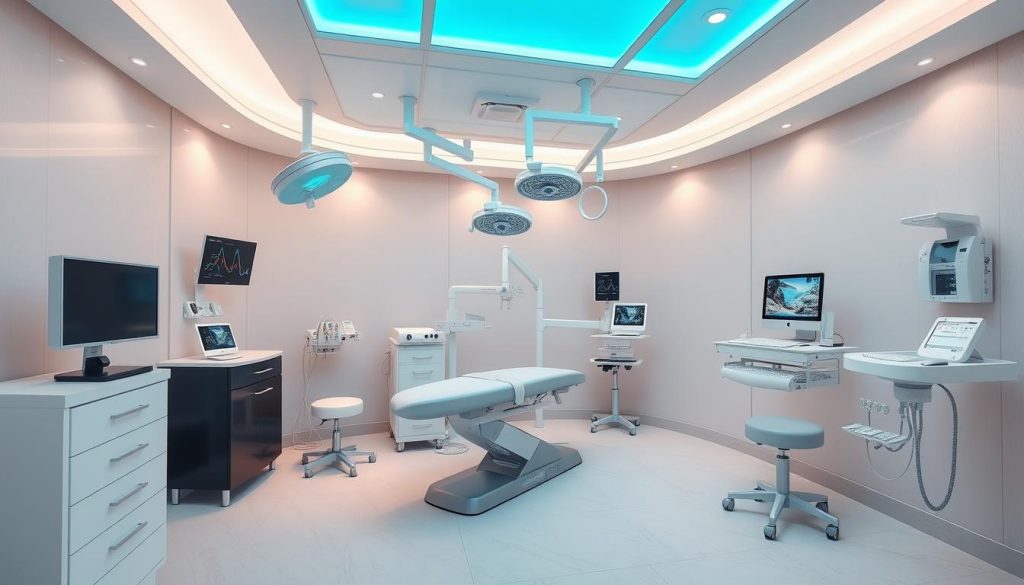
B.V Clinic, led by the expertise of Dr. Suh, specializes in advanced 3D Thread Lifting targeting the SMAS layer for effective lifting and collagen stimulation. This clinic is recognized for its authority in thread lifting and facial rejuvenation.
These top clinics not only offer advanced nose lift procedures but also provide extensive aftercare programs, including skin regeneration management and nutritional support, ensuring patients receive continuous care throughout their recovery process.
Cost Considerations for Korean Nose Lift
The cost of undergoing a Korean nose lift can vary significantly based on several factors, including the type of procedure, the surgeon’s expertise, and the clinic’s location.
Pricing Factors
Several key factors influence the pricing of Korean nose lift procedures. Surgeon’s expertise and reputation play a significant role, as more experienced surgeons tend to charge higher fees. The clinic’s location is another crucial factor, with clinics in prestigious areas like Gangnam district typically charging premium rates.
The complexity of the procedure also affects the cost. More intricate cases that require extensive reconstruction or revision of previous surgeries demand higher fees due to the additional time, skill, and resources required.
| Procedure Type | Cost Range |
|---|---|
| Surgical Rhinoplasty | $3,000 – $7,000 |
| Thread Lift | $800 – $2,000 |
| Fillers | $400 – $1,000 |
Additional Expenses for International Patients
International patients should budget for additional expenses beyond the procedure itself. These include consultation fees, pre-operative tests, medications, and follow-up appointments.
Travel-related costs such as flights, accommodation (typically 10-14 days for surgical procedures), transportation, and translation services should also be factored into the overall budget.
Many clinics offer package deals for international patients that include airport transfers, accommodation arrangements, and post-operative care, providing convenience and potentially better value.
While Korean nose lift procedures are generally more affordable than equivalent treatments in the United States or Europe, the focus should remain on quality and results rather than seeking the lowest price.
Planning Your Korean Nose Lift Journey
For international patients, planning a Korean nose lift involves several key considerations. The process begins with extensive research to identify a reputable clinic and skilled surgeon.
Travel Arrangements
Travel planning is a crucial aspect of undergoing a Korean nose lift. Korea is well-connected globally, with Incheon International Airport being the primary gateway for most international travelers. Many clinics offer assistance with travel arrangements, including airport pick-up and booking hotels close to the medical facility.
- Plan for direct flights when possible to minimize travel stress and time.
- Arrive at least 1-2 days before the scheduled consultation to recover from jet lag.
- Consider the timing of your visit, avoiding peak travel seasons if possible.
Accommodation Options
The type of accommodation you choose can significantly impact your recovery experience. Options range from luxury hotels to serviced apartments and specialized medical stay facilities.
- Many clinics have partnerships with nearby accommodations that cater to the needs of recovering patients.
- Consider the proximity of your accommodation to the clinic for follow-up care.
- Some clinics offer package deals that include accommodation and post-operative care.
Language and Communication Considerations
Effective communication is vital for a successful nose surgery experience. While many clinics in Seoul have English-speaking staff, additional measures can be taken to ensure smooth communication.
- Some clinics offer translation services or work with medical tourism agencies that provide such services.
- Utilizing translation apps can also help bridge any language gaps.
- Learning basic Korean phrases can enhance your experience and show respect for the local culture.
By carefully planning your Korean nose lift journey, you can ensure a smooth and successful experience. This includes considering time for recovery, choosing the right accommodation, and addressing any language barriers.
Alternatives to Korean Nose Lift
Beyond Korean nose lift, there are multiple approaches to achieving the desired nasal shape and structure. Individuals considering nasal enhancement have various options, ranging from non-surgical treatments to surgical procedures.
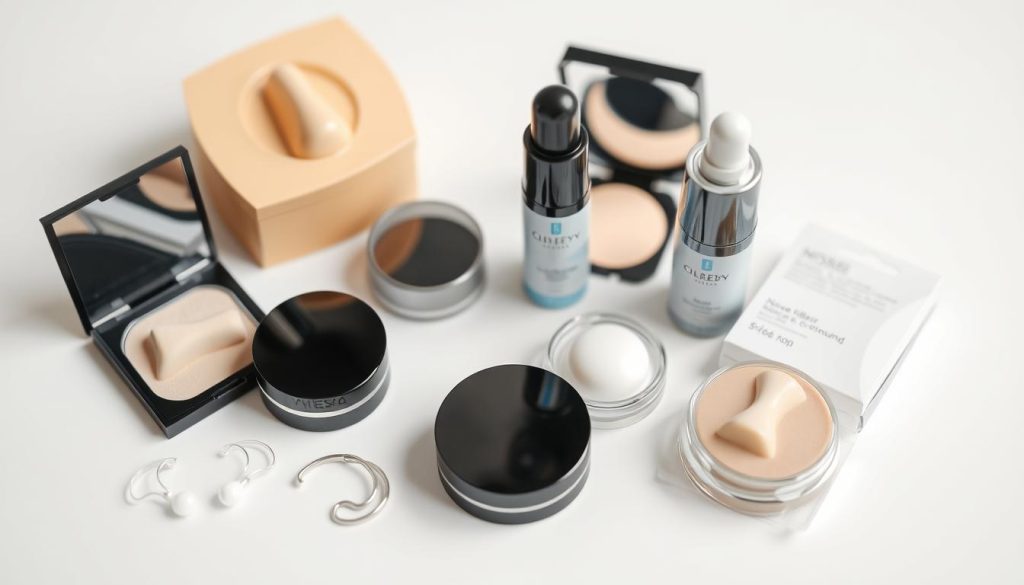
Non-Surgical Options
Non-surgical alternatives to Korean nose lift procedures include temporary solutions like dermal fillers, which can smooth bumps, enhance the bridge, or refine the tip without invasive surgery. Dermal fillers, typically made of hyaluronic acid or calcium hydroxylapatite, offer a quick and relatively painless way to achieve desired nasal contours.
Botox injections are another non-surgical option for minor tip refinement. By relaxing the depressor septi muscle, Botox can create a slight lift effect that lasts 3-4 months, ideal for those seeking subtle, temporary changes.
Liquid rhinoplasty combines various injectable techniques to comprehensively reshape the nose without surgery. This method offers immediate results with minimal downtime but requires maintenance every 6-18 months to sustain the desired appearance.
Surgical Alternatives
For those seeking more permanent solutions, surgical alternatives to Korean nose lift are available. Western surgical rhinoplasty approaches differ from Korean techniques, often focusing more on reduction rather than augmentation, which may be preferable for certain nose types and aesthetic goals.
Preservation rhinoplasty is an emerging surgical technique that maintains the nose’s structural support while making modifications. This approach potentially results in more natural outcomes with less post-operative swelling.
Ultrasonic rhinoplasty uses piezoelectric instruments to precisely sculpt nasal bones without damaging surrounding tissues. This method offers an alternative to traditional surgical methods with potentially reduced trauma and recovery time.
Each alternative comes with its own set of benefits, limitations, and risk profiles. Therefore, a personalized consultation is essential to determine the most appropriate approach for individual needs and goals.
Making an Informed Decision About Korean Nose Lift
The decision to undergo a Korean nose lift requires a thorough understanding of the procedure and its implications. It’s not just about altering the nose; it’s about achieving a harmonious balance with the rest of the facial features.
Understanding the Procedure: Making an informed decision involves comprehensive research into the types of procedures available, including surgical and non-surgical options. Prospective patients should evaluate the benefits, risks, and longevity of results for each type.
Surgeon Qualifications are paramount. Patients should review a surgeon’s educational background, board certifications, specialization in rhinoplasty, and before-and-after portfolios. Patient testimonials can also provide valuable insights into a surgeon’s expertise.
Setting Realistic Expectations is crucial. While a Korean nose lift can significantly enhance one’s appearance, it’s essential to understand that the goal is improvement, not perfection. The results must harmonize with the overall facial features.
Financial Considerations extend beyond the initial procedure cost. Patients should also consider potential revision procedures, follow-up care, and, for international patients, travel expenses and time away from work.
Timing is also important. Patients should plan the procedure at a time that allows for adequate recovery before major life events. Seasonal factors, such as preferring winter months when sun exposure is limited, can also impact the decision.
Psychological Readiness is another critical factor. The decision to undergo a Korean nose lift should be made for personal satisfaction, not external pressure. Patients should have a clear understanding of how the change may impact their self-perception.
Finally, consulting with multiple surgeons can provide valuable perspectives and help patients find a practitioner whose aesthetic vision and techniques align with their goals.
FAQ
What is the typical recovery time for a rhinoplasty procedure?
The recovery time can vary, but most patients can expect to return to their normal activities within one to two weeks. However, it may take several months for the final results to be fully visible.
Will I be under general anesthesia during the procedure?
Yes, general anesthesia is typically used for rhinoplasty procedures to ensure the patient’s comfort and safety during the surgery.
How long does a nose thread lift procedure take?
A nose thread lift is a relatively quick procedure, usually taking around 30 minutes to an hour to complete.
What are the potential risks and complications associated with rhinoplasty?
As with any surgical procedure, there are risks and potential complications, including infection, bleeding, and adverse reactions to anesthesia. It’s essential to discuss these risks with a qualified practitioner.
Can I undergo rhinoplasty if I have a deviated septum?
Yes, individuals with a deviated septum can undergo rhinoplasty. In fact, correcting a deviated septum can improve breathing and overall nasal function.
How do I choose the right clinic for my rhinoplasty procedure?
When selecting a clinic, consider factors such as the practitioner’s expertise, the clinic’s reputation, and the quality of care provided. It’s also essential to review before-and-after photos and read patient testimonials.
Are there any non-surgical alternatives to rhinoplasty?
Yes, there are non-surgical options, such as dermal fillers, that can be used to enhance the appearance of the nose. However, these alternatives are typically temporary and may not achieve the same level of results as surgical rhinoplasty.
What are the costs associated with rhinoplasty in Seoul?
The cost of rhinoplasty in Seoul can vary depending on factors such as the type of procedure, the practitioner’s fees, and the clinic’s location. It’s essential to consult with a qualified practitioner to get an accurate estimate.
